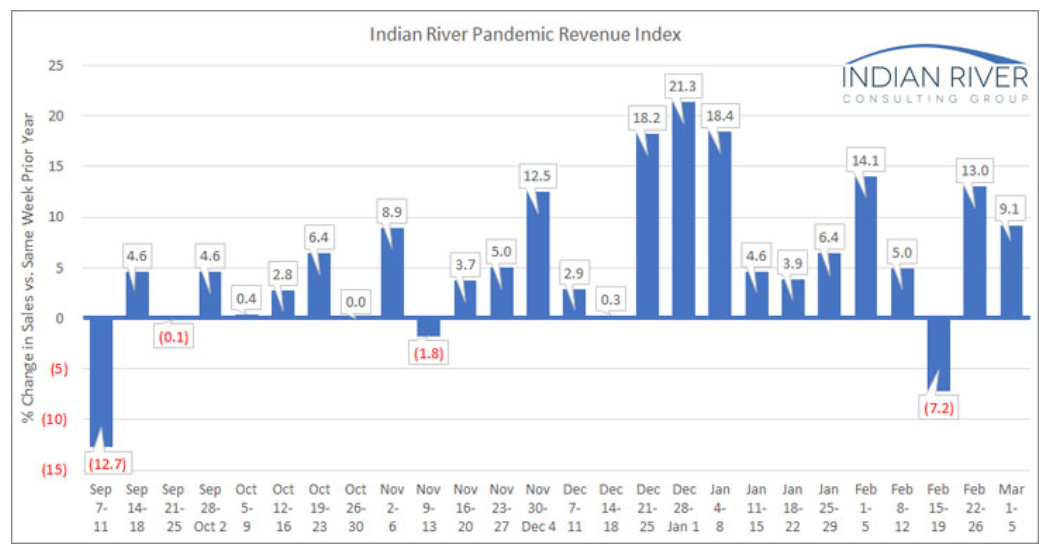IRCG reviews 2020 Pandemic Revenue Index
Index authors look back at 2020, an unstable year for distributors.
About one year into the pandemic, we wrapped on our weekly Pandemic Revenue Index after 50 straight weeks, with the final index published for the week of March 1-5, 2021.

We started the Pandemic Revenue Index to give distributors a weekly, quantified view into how other distributors in the industry were faring with respect to revenue declines in an unusual and uncertain time. We knew there was going to be instability; so, if distributors could access what markets were doing weekly, it would give them the perspective they needed to keep moving forward.
We saw both extremes over the past year – from a low the week of April 6, 2020, with an average decline of a little over 30%. And we saw a high (21.3% increase) in the index the week of Dec. 28, 2020, thanks to a favorable comparison due to how the holidays fell.
More recently, we’ve seen consistent increases that are likely to prevail moving forward.
Over the 50 weeks of the Pandemic Revenue Index, sales averaged out to be relatively flat (-0.1%), with the latter part of 2020 and the start of 2021 offsetting the deep declines we saw at the start of the pandemic.
Our index was started with eight distributors and grew to 14 from various industry segments. They are professionally-run businesses that showed an distinct ability to adapt well to the shifts we saw in 2020. Within the group, those that showed the strongest sales performance had some characteristics in common:
- Sold into essential markets
- Recognized early on that they’d need to leverage their balance sheets and increase safety stock for when demand returned
- Capitalized on product opportunities outside of their core, including safety and cleaning supplies
Those who struggled the most either served markets that slowed or shut down entirely for a short period. But despite these challenges, distributors were resilient. They weren’t held back by demand constraints in most cases; it was more an inventory constraint.
They didn’t have inventory to meet the demand that was there. In fact, backorders are still a struggle for many distributors, with some products facing up to a year’s lead time. Think about how many suppliers contribute to one supply chain, with production across different countries for different parts. As production shut down with little to no warning due to COVID outbreaks or other restrictions, distributors were sometimes left shorthanded. Some still are. You can’t sell what you don’t have.
Based on the lessons of 2020, well-run distributors are adapting to better navigate future uncertainty with:
Greater supply chain resilience and inventory visibility. Distributors are using their technology to help them better see and manage demand and inventory levels, with min/max functionality that integrates lead times. Distributors are also expanding safety stock of their fastest-moving items and finding alternative sources of supply.
Transparency. Employees, customers and suppliers should all know what you're doing and why you're doing it, especially in times of instability and uncertainty. That’s how you ensure you’re building and not destroying trust.
Stress testing. A stress test measures a business’s resilience when subjected to unexpected shocks and subsequent operational changes. Analyzing different scenarios, a stress test determines where you stand with cash flow and identifies how much you would need to reduce costs. This information better prepares distributors when an unexpected event occurs.
Sales channel strategy to resist future shocks. Distributors are evaluating sales force structures and proactively integrating digital while building on remote selling skills brought on by the pandemic. They are evaluating selling costs and whether their current system reflects how customers actually want to buy.
Embracing data. Detail-oriented leadership actively fights for clean data to make sure it’s usable for guiding transformation processes to drive decisions and cut sales costs. For instance, segmenting customer data can help reveal customers who do not need the economic investment of a field sales rep, leading to a more productive territory design.
Thank you to the distributors that provided data each week for our Pandemic Revenue Index. Let’s hope we never have to do this again.
Learn more at www.ircg.com
















